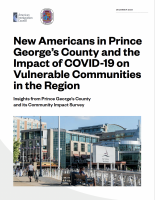- Research and Analysis
New Americans in Prince George's County and the Impact of COVID-19 on Vulnerable Communities in the Region
Insights from Prince George's County and its Community Impact Survey
Published
The COVID-19 pandemic has disproportionally affected vulnerable communities across the United States, including racial and ethnic minorities and immigrant groups. Many faced and continue to face severe challenges in meeting the essential needs of their families and handling mental health issues, both of which were exacerbated by the prolonged stress and isolation of the pandemic.
To better support the vulnerable communities in Prince George’s County, the American Immigration Council (the Council) partnered with Prince George’s County, Maryland, under the leadership of former Councilmember Deni Taveras, and local community organizations, to survey Prince George's County residents about their experiences during the pandemic. The COVID-19 Community Impact Survey, conducted between October and December of 2022, asked Black, Indigenous, and other people of color (BIPOC) and immigrant communities in Prince George's County about the essential needs of their families; the impact of COVID-19 on their wellbeing; and the help they received from local organizations. New research from the Council, New Americans in Prince George’s County and the Impact of COVID-19 on Vulnerable Communities in the Region, shares the key findings and analysis of the COVID-19 Community Impact Survey.
Additionally, the report includes new research from the Council highlighting the demographic and economic contributions of immigrants in Prince George’s County, emphasizing the crucial role immigrants play in the region’s labor force, consumer spending power, and more. It also features two profiles of immigrant residents: Katty De La Paz and Phillip Njowusi.
-
Immigrants form a significant part of Prince George’s County’s population: In 2019, immigrants numbered more than 208,000, comprising 22.9 percent of the population, and between 2014 and 2019, the county’s immigrant population grew by 13.3 percent.
-
Immigrants are strong drivers of the county’s economy: In 2019, immigrant households earned $6.9 billion and paid $1.8 billion in taxes, including $723 million in state and local taxes. In total, immigrant households held $5.1 billion in spending power and contributed $11.9 billion of Prince George’s County’s Gross Domestic Product (GDP).
-
A significant share of Black, Indigenous, other people of color, and immigrant residents in Prince George’s County experienced financial hardship during the pandemic: More than 69 percent of Black, Indigenous, other people of color, and immigrants had to reduce other essential spending to pay their rent or mortgage, with Black, Indigenous, and other people of color being most worried about having enough food to feed their family, paying utilities or other bills, and paying down debt.
-
Access to quality, timely health care is essential to preserve a community’s wellbeing, yet many Black, Indigenous, other people of color, and immigrants face barriers when trying to go to the doctor: More than 83 percent of Black, Indigenous, and other people of color and nearly 84 percent of immigrants said they did not have access to paid sick time if they became ill, and over one-third of Black, Indigenous, other people of color, and immigrants were unable to access needed medical care during the pandemic – with many citing financial concerns as the reason.
-
Community organizations are providing Black, Indigenous, other people of color, and immigrant residents with much-needed assistance: More than 58 percent of Black, Indigenous, other people of color, and immigrants agreed that there is a local organization that they can turn to for help getting their basic needs met; however, nearly 14 percent of Black, Indigenous, and other people of color respondents and over 14 percent of immigrant respondents reported not having a local organization they could rely on for assistance.
-
Securing stable employment — which was dramatically impacted by the pandemic — continues to represent obstacles for Black, Indigenous, other people of color, and immigrant residents: More than 40 percent of Black, Indigenous, and other people of color and nearly 42 percent of immigrants reported that they are employed in the formal sector with a full-time job. During the pandemic: 35 percent of both Black, Indigenous, other people of color, and immigrants reported that they lost a job, and over 50 percent of both groups reported having their hours reduced.

